人教版(2019)选择性必修第二册Unit 1 Science and Scientists Learning About Language课件(共24张PPT,内镶嵌视频)
文档属性
| 名称 | 人教版(2019)选择性必修第二册Unit 1 Science and Scientists Learning About Language课件(共24张PPT,内镶嵌视频) | 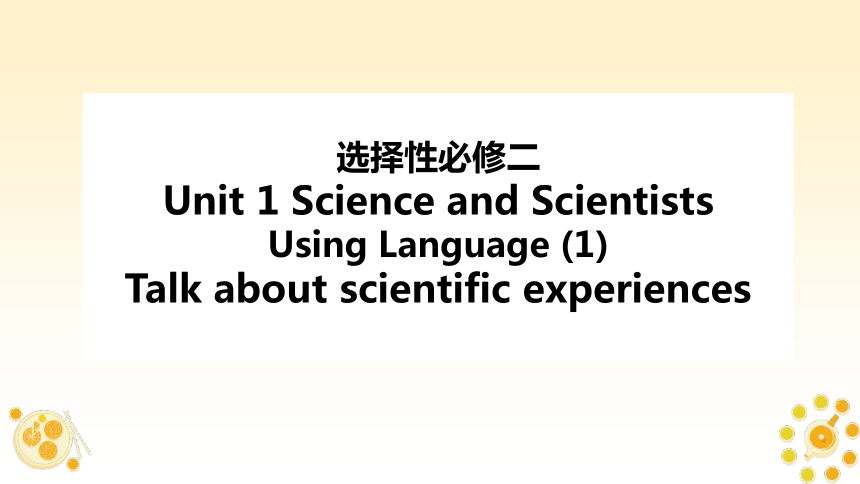 | |
| 格式 | pptx | ||
| 文件大小 | 46.2MB | ||
| 资源类型 | 教案 | ||
| 版本资源 | 人教版(2019) | ||
| 科目 | 英语 | ||
| 更新时间 | 2024-03-08 14:43:15 | ||
图片预览

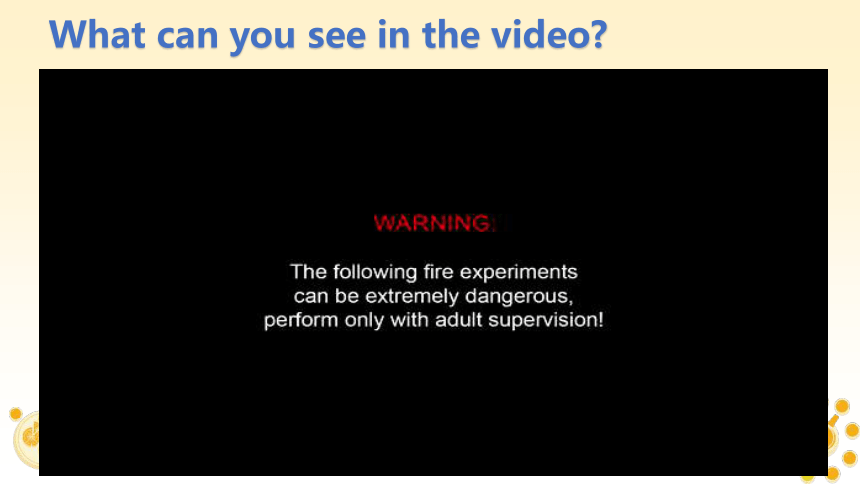
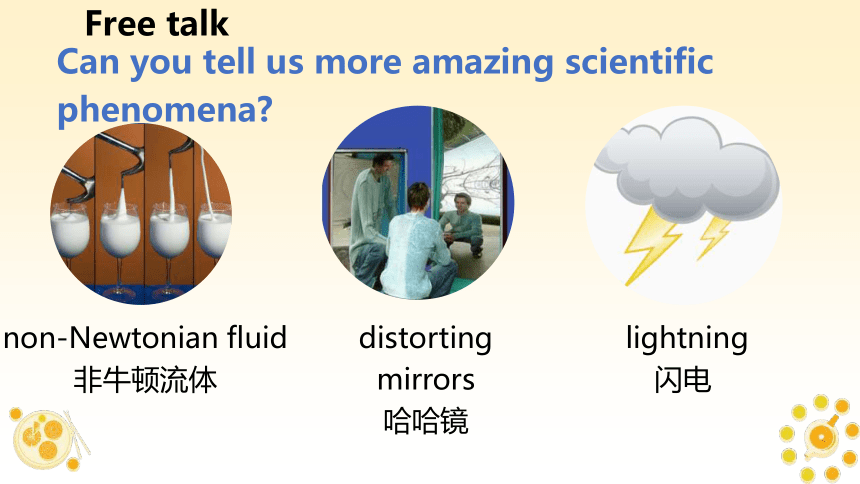
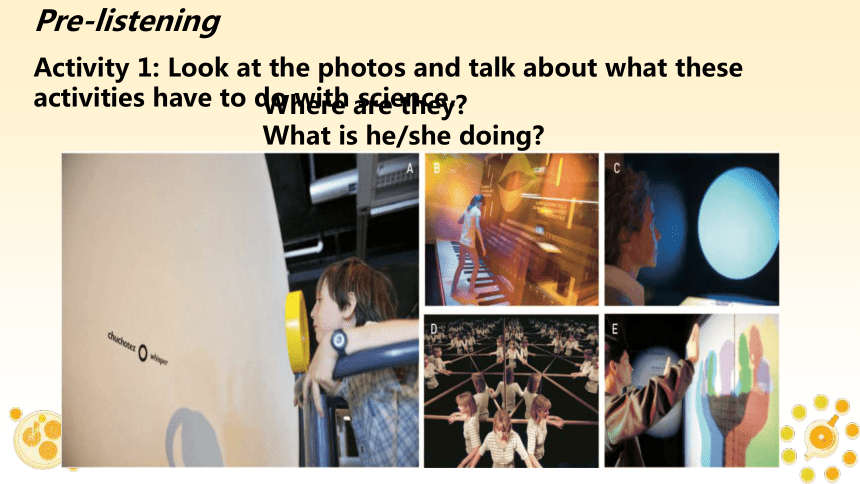
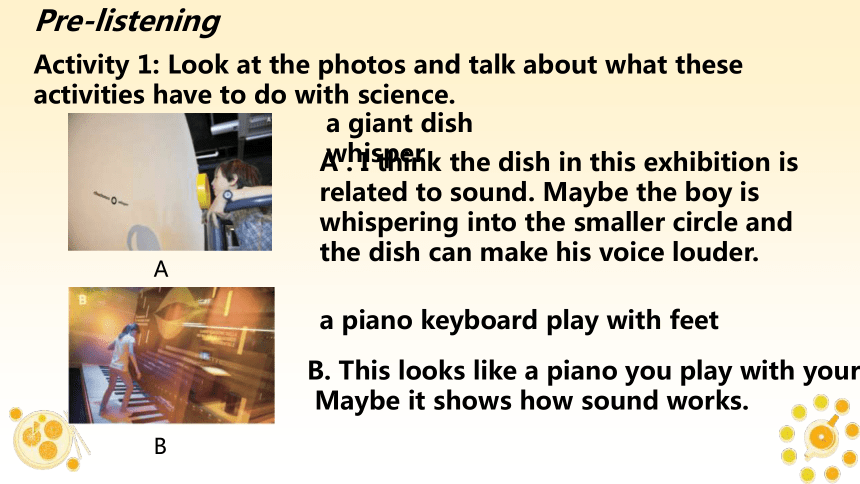
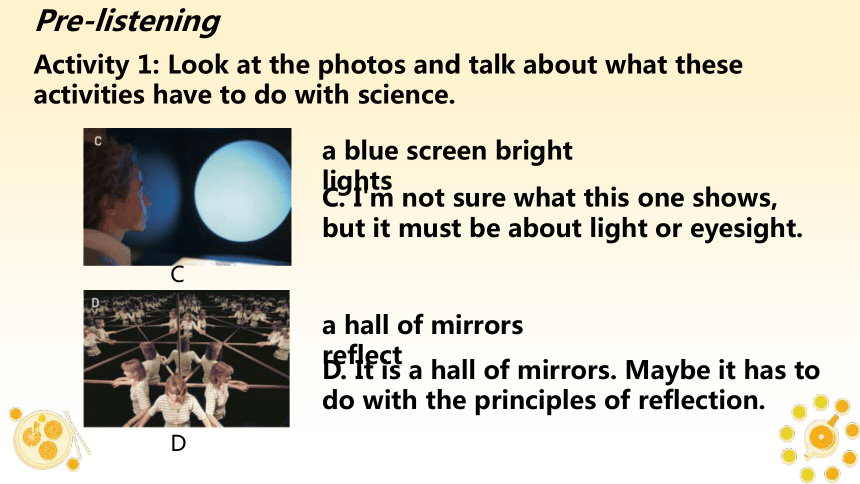
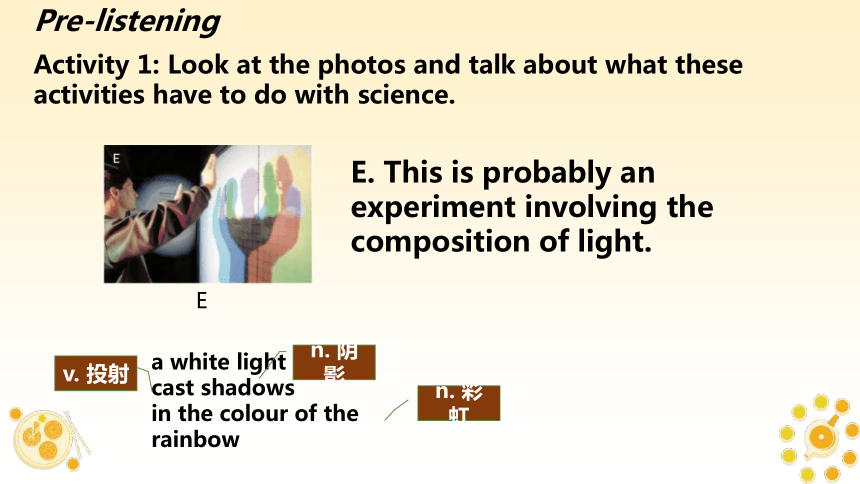
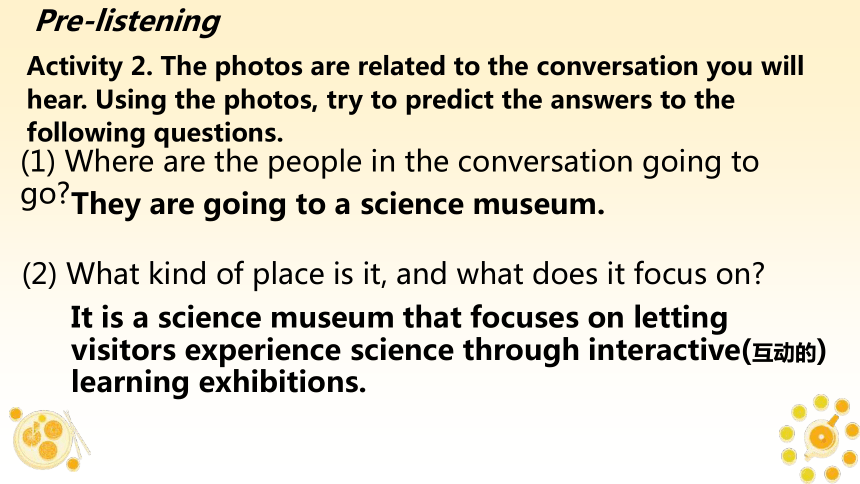
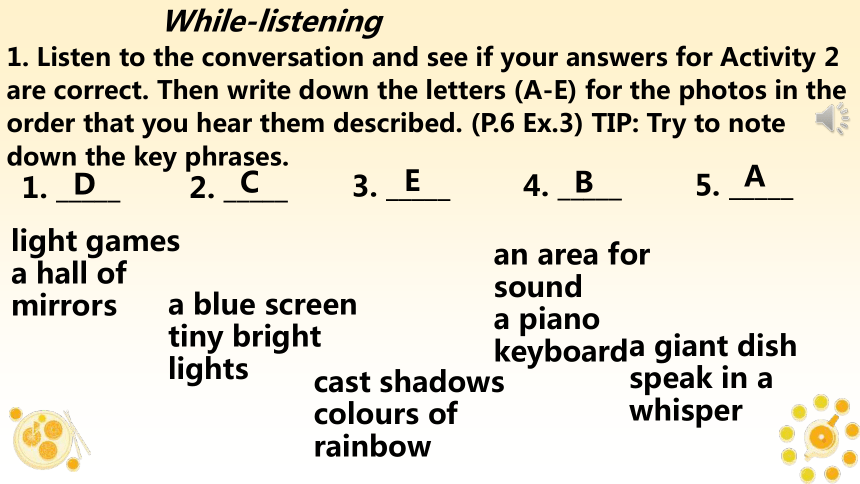
文档简介
(共24张PPT)
选择性必修二
Unit 1 Science and Scientists
Using Language (1)
Talk about scientific experiences
In this class, students will
get information about Judy’s experience in the scientific museum;
talk about different scientific experiences.
Brainstorm scientific research and experiment
Learning objectives
What can you see in the video
Free talk
Can you tell us more amazing scientific phenomena
non-Newtonian fluid
非牛顿流体
distorting mirrors
哈哈镜
lightning
闪电
Pre-listening
Where are they
What is he/she doing
Activity 1: Look at the photos and talk about what these activities have to do with science.
Activity 1: Look at the photos and talk about what these activities have to do with science.
B
a piano keyboard play with feet
A
A . I think the dish in this exhibition is related to sound. Maybe the boy is whispering into the smaller circle and the dish can make his voice louder.
B. This looks like a piano you play with your feet.
Maybe it shows how sound works.
Pre-listening
a giant dish whisper
C
D
a hall of mirrors reflect
a blue screen bright lights
C. I'm not sure what this one shows, but it must be about light or eyesight.
D. It is a hall of mirrors. Maybe it has to do with the principles of reflection.
Activity 1: Look at the photos and talk about what these activities have to do with science.
Pre-listening
E
a white light
cast shadows
in the colour of the rainbow
n. 彩虹
n. 阴影
v. 投射
E. This is probably an experiment involving the composition of light.
Activity 1: Look at the photos and talk about what these activities have to do with science.
Pre-listening
Activity 2. The photos are related to the conversation you will hear. Using the photos, try to predict the answers to the following questions.
(1) Where are the people in the conversation going to go
(2) What kind of place is it, and what does it focus on
They are going to a science museum.
It is a science museum that focuses on letting visitors experience science through interactive(互动的) learning exhibitions.
Pre-listening
(3) What kinds of things can you do there
You can probably try different activities to learn about sound, light, reflection, and so on. For example, you can go to a room with many mirrors facing each other so it looks like there are many copies of you! You can also play with a big piano on the floor.
Pre-listening
Activity 2. The photos are related to the conversation you will hear. Using the photos, try to predict the answers to the following questions.
Predict by using pictures
One way to get more out of your listening is to predict what you will hear. Using the pictures provided and the knowledge you already have, you can guess the kinds of information you should listen for. At times, you may even be able to guess exactly what will be talked about. This will help you focus better when listening, making your listening more effective.
What can we predict in these pictures
1. Who What Where When
2. Can we classify them into different types
Picture A & B: sound; Picture C&D&E: light.
Located in Paris, France, the City of Science and Industry is the biggest science museum in Europe. The goal of the City is to spread scientific and technical knowledge among the public, particularly the youth, and to promote public interest in science, research and industry. Attractions include a planetarium, a submarine, an IMAX theatre and special areas for children and teenagers, where games, interactive exhibits, and experimental areas allow them to really get their thinking caps on to explore.
Cultural Note: the City of Science and Industry
n. 天文馆/,pl n ’te ri m/
n. 潜艇
/,s bm ’ri n/
开动脑筋
图片来源于网络
While-listening
1. Listen to the conversation and see if your answers for Activity 2 are correct. Then write down the letters (A-E) for the photos in the order that you hear them described. (P.6 Ex.3) TIP: Try to note down the key phrases.
1. _____
2. _____
3. _____
4. _____
5. _____
light games
a hall of mirrors
a blue screen
tiny bright lights
cast shadows
colours of rainbow
an area for sound
a piano keyboard
a giant dish
speak in a whisper
D
C
E
B
A
While-listening
2. Listen again and complete the descriptions of the photos. (P.6 Ex.4)
Photo A: A giant dish; when you speak into it, it __________ the sound back and
_______________. You can use it to speak in a _________ to someone 17 meters away.
Photo B: A giant ______________ that you can use your feet to play. Instead of playing the
sounds of a piano, it plays the voices of________________.
Photo C: You look at a blue screen for a while, and then suddenly you can see
________________ moving around on it. These are our_________________.
Photo D: A ________________ where you can see yourself reflected thousands of times.
Photo E: You stand in front of _____________ and it casts different shadows of you,
in ___________________ the rainbow.
reflects
makes it louder
whisper
piano keyboard
classical singers
tiny bright lights
own blood cells
hall of mirrors
a white light
every colour of
listening material
Judy: Oh, I'm so sorry that you were ill and couldn't come with us on our field trip. How are you feeling now Better
Bill: Much better, thanks. But how was it
Judy: Wonderful! I especially liked an area of the museum called Light Games.it was really cool. They had a hall of mirrors where I could see myself reflected thousands of times!
Bill: A hall of mirrors can be a lot of fun. What else did they have
Judy: Well, they had an experiment where we looked at a blue screen for a while, and then suddenly we could see tiny bright lights moving around on it. You'll never guess what those bright lights were!
Bill: Come on, tell me!
Judy: They were our own blood cells. For some reason, our eyes play tricks on us when we look at a blue screen, and we can see our own blood cells moving around like little lights!
But there was another thing I liked better. I stood in front of a white light, and it cast different shadows of me in every color of the rainbow!
Bill: Oh, I wish I had been there. Tell me more!
Judy: Well, they had another area for sound. They had a giant piano keyboard that you could use your feet to play. But then, instead of playing the sounds of a piano, it played the voices of classical singers! Then they had a giant dish, and when you spoke into it, it reflected the sound back and made it louder. You could use it to speak in a whisper to someone 17 metres away.
Bill: It all sounds so cool. I wish I could have gone with you.
Judy: I know, but we can go together this weekend. I'd love to go there again!
Bill: That sounds like a great idea!
listening material
The conversation is about the City of Science and Industry, a museum in Paris. Would you like to go to this museum Why or why not
No.
It is not convenient because it is too far from China and there is no need to go so far when we have so many interesting places at home.
We can’t speak French and will have trouble in understanding what to do there.
Post-listening: talk about something more on the scientific museum
Yes.
I would like to go to this museum to see the blue screen. I am curious to know what on earth is going on there and why I can see my blood cells moving around like tiny bright lights. I am sure it will be a lot of fun.
2. If you were a guide in the science museum, what science phenomenon will you introduce to visitors
Let's talk about scientific phenomena
Today, I want to talk to you about a very strange phenomenon called a non-Newtonian liquid. You can make it easily using equal parts of water and cornflour, like I have here. A non-Newtonian fluid is strange because you can pour it like a liquid, but if you put any pressure on it, it suddenly becomes hard as concrete. In fact, it becomes hard enough to stand on. Then, as soon as you take the pressure off, it becomes a liquid again.This show that it is possible that something can exist as a liquid and a solid at the same time.
topic
explanation
summary
Post-listening: Sample Study
Talk about the “Water Film Experiment” in the Tiangong space station.
EXAMPLE
Today, I want to talk to you about a very strange phenomenon called…
You can make it easily using …
This shows that…
Post-listening: talk about scientific phenomena
useful expressions:
Talk about a scientific phenomenon in your daily life.
temperature / tempr t (r)/ (n.)温度
humidity /hju m d ti/ (n.)湿度
moisture / m st (r)/ (n.)水分
condense /k n dens/ (v.)冷凝
Word Bank
图片来源于网络
Eg. Have you ever seen a foggy window
of a car When does it happen Why
2. Homework: Talk about a scientific phenomenon in your daily life.
foggy car windows
topic
Today, I want to talk to you about an interesting phenomenon in our daily life.
Process
Theory
图片来源于网络
Sometimes, our car windows get foggy. This occurs when there is a difference in air temperature and humidity between the inside of the car and the outside.
Phenomenon
① If you get into the car when it is cold outside, your warm body temperature and the moisture coming from your breath will increase the humidity in the car.
② When this humid and warm air touches the cold glass, the water in the air condenses on the glass to create fog.
Though this, we know that water condenses when warm air touches the cold glass. This is how fog is formed on the car windows.
3. Think about the function of science:
Why do we study science What can we do with scientific knowledge
Thank you for your attention!
选择性必修二
Unit 1 Science and Scientists
Using Language (1)
Talk about scientific experiences
In this class, students will
get information about Judy’s experience in the scientific museum;
talk about different scientific experiences.
Brainstorm scientific research and experiment
Learning objectives
What can you see in the video
Free talk
Can you tell us more amazing scientific phenomena
non-Newtonian fluid
非牛顿流体
distorting mirrors
哈哈镜
lightning
闪电
Pre-listening
Where are they
What is he/she doing
Activity 1: Look at the photos and talk about what these activities have to do with science.
Activity 1: Look at the photos and talk about what these activities have to do with science.
B
a piano keyboard play with feet
A
A . I think the dish in this exhibition is related to sound. Maybe the boy is whispering into the smaller circle and the dish can make his voice louder.
B. This looks like a piano you play with your feet.
Maybe it shows how sound works.
Pre-listening
a giant dish whisper
C
D
a hall of mirrors reflect
a blue screen bright lights
C. I'm not sure what this one shows, but it must be about light or eyesight.
D. It is a hall of mirrors. Maybe it has to do with the principles of reflection.
Activity 1: Look at the photos and talk about what these activities have to do with science.
Pre-listening
E
a white light
cast shadows
in the colour of the rainbow
n. 彩虹
n. 阴影
v. 投射
E. This is probably an experiment involving the composition of light.
Activity 1: Look at the photos and talk about what these activities have to do with science.
Pre-listening
Activity 2. The photos are related to the conversation you will hear. Using the photos, try to predict the answers to the following questions.
(1) Where are the people in the conversation going to go
(2) What kind of place is it, and what does it focus on
They are going to a science museum.
It is a science museum that focuses on letting visitors experience science through interactive(互动的) learning exhibitions.
Pre-listening
(3) What kinds of things can you do there
You can probably try different activities to learn about sound, light, reflection, and so on. For example, you can go to a room with many mirrors facing each other so it looks like there are many copies of you! You can also play with a big piano on the floor.
Pre-listening
Activity 2. The photos are related to the conversation you will hear. Using the photos, try to predict the answers to the following questions.
Predict by using pictures
One way to get more out of your listening is to predict what you will hear. Using the pictures provided and the knowledge you already have, you can guess the kinds of information you should listen for. At times, you may even be able to guess exactly what will be talked about. This will help you focus better when listening, making your listening more effective.
What can we predict in these pictures
1. Who What Where When
2. Can we classify them into different types
Picture A & B: sound; Picture C&D&E: light.
Located in Paris, France, the City of Science and Industry is the biggest science museum in Europe. The goal of the City is to spread scientific and technical knowledge among the public, particularly the youth, and to promote public interest in science, research and industry. Attractions include a planetarium, a submarine, an IMAX theatre and special areas for children and teenagers, where games, interactive exhibits, and experimental areas allow them to really get their thinking caps on to explore.
Cultural Note: the City of Science and Industry
n. 天文馆/,pl n ’te ri m/
n. 潜艇
/,s bm ’ri n/
开动脑筋
图片来源于网络
While-listening
1. Listen to the conversation and see if your answers for Activity 2 are correct. Then write down the letters (A-E) for the photos in the order that you hear them described. (P.6 Ex.3) TIP: Try to note down the key phrases.
1. _____
2. _____
3. _____
4. _____
5. _____
light games
a hall of mirrors
a blue screen
tiny bright lights
cast shadows
colours of rainbow
an area for sound
a piano keyboard
a giant dish
speak in a whisper
D
C
E
B
A
While-listening
2. Listen again and complete the descriptions of the photos. (P.6 Ex.4)
Photo A: A giant dish; when you speak into it, it __________ the sound back and
_______________. You can use it to speak in a _________ to someone 17 meters away.
Photo B: A giant ______________ that you can use your feet to play. Instead of playing the
sounds of a piano, it plays the voices of________________.
Photo C: You look at a blue screen for a while, and then suddenly you can see
________________ moving around on it. These are our_________________.
Photo D: A ________________ where you can see yourself reflected thousands of times.
Photo E: You stand in front of _____________ and it casts different shadows of you,
in ___________________ the rainbow.
reflects
makes it louder
whisper
piano keyboard
classical singers
tiny bright lights
own blood cells
hall of mirrors
a white light
every colour of
listening material
Judy: Oh, I'm so sorry that you were ill and couldn't come with us on our field trip. How are you feeling now Better
Bill: Much better, thanks. But how was it
Judy: Wonderful! I especially liked an area of the museum called Light Games.it was really cool. They had a hall of mirrors where I could see myself reflected thousands of times!
Bill: A hall of mirrors can be a lot of fun. What else did they have
Judy: Well, they had an experiment where we looked at a blue screen for a while, and then suddenly we could see tiny bright lights moving around on it. You'll never guess what those bright lights were!
Bill: Come on, tell me!
Judy: They were our own blood cells. For some reason, our eyes play tricks on us when we look at a blue screen, and we can see our own blood cells moving around like little lights!
But there was another thing I liked better. I stood in front of a white light, and it cast different shadows of me in every color of the rainbow!
Bill: Oh, I wish I had been there. Tell me more!
Judy: Well, they had another area for sound. They had a giant piano keyboard that you could use your feet to play. But then, instead of playing the sounds of a piano, it played the voices of classical singers! Then they had a giant dish, and when you spoke into it, it reflected the sound back and made it louder. You could use it to speak in a whisper to someone 17 metres away.
Bill: It all sounds so cool. I wish I could have gone with you.
Judy: I know, but we can go together this weekend. I'd love to go there again!
Bill: That sounds like a great idea!
listening material
The conversation is about the City of Science and Industry, a museum in Paris. Would you like to go to this museum Why or why not
No.
It is not convenient because it is too far from China and there is no need to go so far when we have so many interesting places at home.
We can’t speak French and will have trouble in understanding what to do there.
Post-listening: talk about something more on the scientific museum
Yes.
I would like to go to this museum to see the blue screen. I am curious to know what on earth is going on there and why I can see my blood cells moving around like tiny bright lights. I am sure it will be a lot of fun.
2. If you were a guide in the science museum, what science phenomenon will you introduce to visitors
Let's talk about scientific phenomena
Today, I want to talk to you about a very strange phenomenon called a non-Newtonian liquid. You can make it easily using equal parts of water and cornflour, like I have here. A non-Newtonian fluid is strange because you can pour it like a liquid, but if you put any pressure on it, it suddenly becomes hard as concrete. In fact, it becomes hard enough to stand on. Then, as soon as you take the pressure off, it becomes a liquid again.This show that it is possible that something can exist as a liquid and a solid at the same time.
topic
explanation
summary
Post-listening: Sample Study
Talk about the “Water Film Experiment” in the Tiangong space station.
EXAMPLE
Today, I want to talk to you about a very strange phenomenon called…
You can make it easily using …
This shows that…
Post-listening: talk about scientific phenomena
useful expressions:
Talk about a scientific phenomenon in your daily life.
temperature / tempr t (r)/ (n.)温度
humidity /hju m d ti/ (n.)湿度
moisture / m st (r)/ (n.)水分
condense /k n dens/ (v.)冷凝
Word Bank
图片来源于网络
Eg. Have you ever seen a foggy window
of a car When does it happen Why
2. Homework: Talk about a scientific phenomenon in your daily life.
foggy car windows
topic
Today, I want to talk to you about an interesting phenomenon in our daily life.
Process
Theory
图片来源于网络
Sometimes, our car windows get foggy. This occurs when there is a difference in air temperature and humidity between the inside of the car and the outside.
Phenomenon
① If you get into the car when it is cold outside, your warm body temperature and the moisture coming from your breath will increase the humidity in the car.
② When this humid and warm air touches the cold glass, the water in the air condenses on the glass to create fog.
Though this, we know that water condenses when warm air touches the cold glass. This is how fog is formed on the car windows.
3. Think about the function of science:
Why do we study science What can we do with scientific knowledge
Thank you for your attention!
